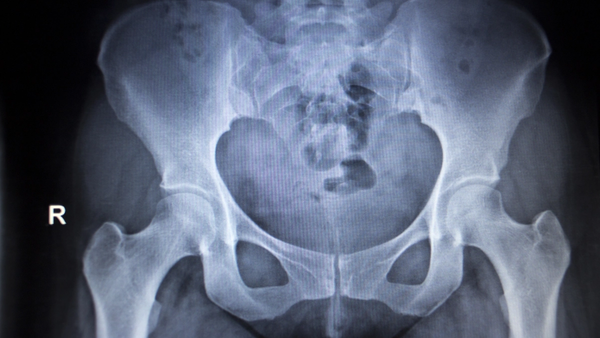Hip osteoarthritis
Hip osteoarthritis, also known as degenerative arthritis, is a condition that affects the hip joint. Hip osteoarthritis can cause pain, stiffness, and limited mobility. The disease usually develops gradually over time and its incidence increases with age. Symptoms include pain in the groin, front, and side of the thigh, which often radiates down to the knee.
At Dr. Dropin, we have skilled practitioners who can assess your hip pain and help you receive the appropriate treatment.
See availability
What are you looking for?
Symptoms of hip osteoarthritis
The following symptoms may indicate the presence of hip osteoarthritis:
- Pain in the hip, especially during exertion or activity.
- Stiffness in the hip, particularly after prolonged periods of inactivity.
- Reduced mobility in the hip, especially when bending, rotating, or stretching.
- Pain radiating down the thigh or toward the knees.
- Hip pain exacerbated by walking, standing, or climbing stairs.
Hip osteoarthritis is a condition that develops over time, and the symptoms can vary from mild to severe. It is important to seek professional help for an accurate diagnosis and to discuss potential treatment options if you experience these symptoms.
See availability
Treatment and prognosis
Treatment of hip osteoarthritis often involves various approaches to achieve specific treatment goals. A long-term focus is also important. Here are some common treatment methods:
- Pain relief: Through manual techniques such as joint adjustments, massage, and trigger point therapy, hip pain can be reduced.
- Increased flexibility: Specific stretching exercises and techniques can help improve mobility in the hip area and surrounding muscles.
- Strength training: Gradual introduction of strength exercises for the muscles around the hip can help strengthen the joints and reduce discomfort.
- Ergonomic adjustments: Adaptations to daily activities and work methods can help reduce unnecessary strain on the hip joint.
- Functional rehabilitation: Gradual resumption of exercise and daily activities, with a focus on restoring optimal function in the hip area.
It is important to understand that the treatment for hip osteoarthritis should be tailored to individual needs and may vary from person to person. A thorough evaluation and close collaboration with experienced professionals, such as physiotherapists or chiropractors, are crucial to develop an effective treatment plan.
Active with osteoarthritis
Treatment of hip osteoarthritis often involves various approaches to achieve specific treatment goals. A long-term focus is also important. Here are some common treatment methods:
- Pain relief: Through manual techniques such as joint adjustments, massage, and trigger point therapy, hip pain can be reduced.
- Increased flexibility: Specific stretching exercises and techniques can help improve mobility in the hip area and surrounding muscles.
- Strength training: Gradual introduction of strength exercises for the muscles around the hip can help strengthen the joints and reduce discomfort.
- Ergonomic adjustments: Adaptations to daily activities and work methods can help reduce unnecessary strain on the hip joint.
- Functional rehabilitation: Gradual resumption of exercise and daily activities, with a focus on restoring optimal function in the hip area.
It is important to understand that the treatment for hip osteoarthritis should be tailored to individual needs and may vary from person to person. A thorough evaluation and close collaboration with experienced professionals, such as physiotherapists or chiropractors, are crucial to develop an effective treatment plan.
When should you book an appointment?
If you recognize the symptoms above and are experiencing any of the following issues, we recommend seeking professional guidance:
- Pain or reduced mobility that has persisted for more than a week without improvement.
- Severe symptoms that you need assistance in reducing quickly.
- Symptoms that cause you concern or that you believe may be due to more serious conditions.
Remember that early assistance from a therapist can reduce the duration of your issues and contribute to achieving the best possible outcome. You should never worry that your problems are "too small" - we take all types of issues seriously.
See availability
Do you want guidance to find out which treatment suits you best?

Telephone
Authorized healthcare personnel assist you over the phone. We answer the phone within 60 seconds. Free of charge.

Find therapist
Find a therapist that suits you and your needs by filtering on one or more criteria.
Use your health insurance
We cooperate with all the major insurance companies, so that you can use your health insurance with us if you have hip pain or other problems.
Read more about how to use your health insurance here
What can you do by yourself?
Although the treatment of hip osteoarthritis typically involves professional guidance and therapy, there are several measures you can take on your own to alleviate symptoms and improve the condition:
- Follow recommended exercises: If you have received home exercises from your therapist, it is important to perform them regularly.
- Stay active: Do not completely stop exercising or engaging in daily activities. If you can remain active without worsening the pain, this is usually acceptable.
- Pain relief: Pain can sometimes be reduced by using an ice pack, heat pack, warm shower, or by performing gentle movements.
- Medications: Use over-the-counter pain relievers as directed.
- Adapt activities: Avoid activities that lead to prolonged worsening of hip pain (more than 12 hours).
- Communicate well with your therapist: So that the treatment plan can be adjusted to the changes you experience.
If you have not had the condition examined yet or have deviated from the treatment plan, it is recommended to contact healthcare professionals for further guidance.
Frequently asked questions about hip osteoarthritis
What is hip osteoarthritis?
Hip osteoarthritis is a degenerative disease that affects the hip joint. The hip joint is responsible for bearing the body’s weight and allowing movement in the hips and legs. Hip osteoarthritis can cause pain, stiffness, and limitations in movement.
What is hip osteoarthritis?
Hip osteoarthritis is a degenerative disease that affects the hip joint. The hip joint is responsible for bearing the body’s weight and allowing movement in the hips and legs. Hip osteoarthritis can cause pain, stiffness, and limitations in movement.
Where does hip osteoarthritis hurt?
The pain in hip osteoarthritis is typically located in and around the hip joint. This includes the groin, thigh, and sometimes even the knees.
Where does hip osteoarthritis hurt?
The pain in hip osteoarthritis is typically located in and around the hip joint. This includes the groin, thigh, and sometimes even the knees.
What helps with hip osteoarthritis?
Some measures that can help with hip osteoarthritis include physiotherapy, pain medications, weight management, and, in some cases, surgery such as hip replacement.
What helps with hip osteoarthritis?
Some measures that can help with hip osteoarthritis include physiotherapy, pain medications, weight management, and, in some cases, surgery such as hip replacement.
What should one avoid when dealing with hip osteoarthritis?
In hip osteoarthritis, it's advisable to avoid prolonged sitting, overloading the hips, and activities that may exacerbate the pain.
What should one avoid when dealing with hip osteoarthritis?
In hip osteoarthritis, it's advisable to avoid prolonged sitting, overloading the hips, and activities that may exacerbate the pain.
Does osteoarthritis get worse over time?
Yes, osteoarthritis can progress over time, and the severity can vary from person to person. It's important to manage the condition in a way that reduces symptoms and slows down the progression.
Does osteoarthritis get worse over time?
Yes, osteoarthritis can progress over time, and the severity can vary from person to person. It's important to manage the condition in a way that reduces symptoms and slows down the progression.
Can exercise alleviate osteoarthritis?
Moderate and tailored exercise can help alleviate symptoms of osteoarthritis. This includes strength and flexibility exercises designed to strengthen the muscles around the joints.
Can exercise alleviate osteoarthritis?
Moderate and tailored exercise can help alleviate symptoms of osteoarthritis. This includes strength and flexibility exercises designed to strengthen the muscles around the joints.